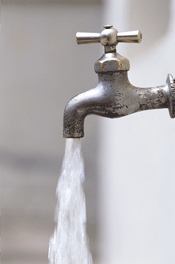Stimulus bill funds water infrastructure projects
The recently approved $787 billion economic stimulus package has $7 billion set aside for drinking-water and wastewater infrastructure projects. While significant, that $7 billion is just a drop in the bucket compared with the work needed to bring the nation’s aging water systems up to date.

Over the next 20 years, some $277 billion must be invested to keep our drinking-water systems from falling further into disrepair, according to the U.S. Environmental Protection Agency (EPA).
The Denver-based American Water Works Association (AWWA) recently calculated that there were at least $10 billion in drinking-water infrastructure projects that could begin construction within 120 days of passage of a stimulus bill. The AWWA’s membership includes more than 4,600 utilities, government districts and city departments that supply water to 180 million people in North America.
A survey by the Washington, D.C.-based Association of Metropolitan Water Agencies (AMWA) shows that there are at least $3 billion worth of “ready-to-go” projects at the nation’s metropolitan drinking-water systems serving more than 100,000 people. The final stimulus legislation passed by Congress gives priority to “ready-to-go” projects, and requires that all projects receiving funds must be on a state’s priority list. The stimulus monies will be distributed as outright grants or as loans through each state’s Clean Water State Revolving Fund program.
The AMWA, which represents the largest publicly owned drinking-water systems in the United States, noted that “other surveys covering drinking-water systems of all sizes have identified about $10 billion worth of ‘ready-to-go’ projects’ that could be started in 2009.”
File ready-to-go projects with SRF agencies
AMWA Executive Director Diane VanDe Hei told GovPro.com that water utility officials should file their ready-to-go projects with their states’ respective Clean Water State Revolving Fund (SRF) agencies, “even if the utility hasn’t received SRF funding in the past.”
“Utilities should also be ready to document how many jobs their projects would create, because many states will be on the lookout for water projects that will put the most people to work,” she said.
Now that the stimulus legislation has been signed into law, city and county officials should stay in the loop, said Lori Harrison, director, public information, at the Alexandria, Va.-based not-for-profit Water Environment Federation (WEF).
“We have advised local government officials to contact their state clean-water or drinking-water program or the State Revolving Fund program managers to make sure that any projects they would like to have funded are on the state’s priority list,” Harrison told GovPro.com. “Many states have sent letters to municipalities in the last few weeks outlining the process or contingency plans they are developing for awarding stimulus monies. Some states, such as California, have held regional workshops on the issue.
“On the state level, the best advice (for local government officials) is to be in touch with their U.S. EPA regional office. We expect that EPA will be issuing guidance or regulations for states to follow in awarding the stimulus funds soon after the funding bill is passed. These details will be posted to www.wef.org and www.epa.gov when available.”
To visit the WEF’s stimulus funding resource Web page, click here.
Loads of projects waiting to be funded
While $7 billion may be a drop in the bucket when it comes to the nation’s water infrastructure needs, it still can accomplish a lot of good. According to the publishers of the “McIlvaine Municipal Wastewater Facilities and People database,” the stimulus package could fast-track 400 wastewater projects valued at $6 billion – projects that otherwise would have remained on the back burner due to lack of funding.
From coast to coast, water-treatment plants are in desperate need of funding. Some examples from McIlvaine:
- In Connecticut, municipal wastewater- and sewage-treatment plants are counting on $135 million from the stimulus package for construction and upgrades.
- Vero Beach, Fla., needs to build a new wastewater plant to replace a 30-year-old plant that is nearing the end of its life and is inadequate for present needs. The cost is projected at $100 million. Lack of funds has prevented the project from going forward. The city is optimistic that the stimulus funding will allow it to begin soon through availability of interest-free loans.
- Live Oak, Fla., is requesting $20 million, which will cover the total cost of five projects that have been permitted, engineered and awarded bids. Among the projects are the second phase of the wastewater-treatment plant, the relocation of the city well fields, and the rehabilitation of the sanitary sewer system.
- Barre City, Vt., is looking at the stimulus package as a way to move forward with a $5 million wastewater upgrade.
- The county of Hawaii is looking for support on $487 million of projects from the stimulus package. Several wastewater projects are included.
- In Suffolk County, N.Y., the county’s Wastewater Task Force has announced 19 sewer-related projects, nine of which would be ready for immediate implementation for stimulus funding. The projects, which total $746 million in value, are projected to create 36,242 jobs and bring $4.7 billion into the local economy.
- Barstow and San Bernardino County, Calif., are hoping to position themselves to take advantage of any funds that may trickle down. The Barstow wastewater-plant upgrade probably would be eligible for funding through the State Revolving Fund, which would receive about $415 million under the stimulus package.
- Washington state anticipates $101 million for wastewater-treatment projects due to the stimulus plan.
For more information on the “Municipal Wastewater Treatment Facilities and People” service, click here.




















